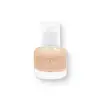What's inside
What's inside
 Key Ingredients
Key Ingredients

 Benefits
Benefits

 Concerns
Concerns

 Ingredients Side-by-side
Ingredients Side-by-side

Cyclopentasiloxane
EmollientButylene Glycol
HumectantVinyl Dimethicone/Lauryl Dimethicone Crosspolymer
Stearyl Dimethicone
EmollientOctadecene
SolventPEG-10 Dimethicone
Skin ConditioningCetyl PEG/PPG-10/1 Dimethicone
EmulsifyingDimethicone
EmollientButylene Glycol Dicaprylate/Dicaprate
EmollientAcrylates/Polytrimethylsiloxymethacrylate Copolymer
Skin ConditioningPolymethyl Methacrylate
Silica
AbrasiveAlumina
AbrasiveAcrylates/Dimethicone Copolymer
Skin ConditioningIsododecane
EmollientMethyl Trimethicone
Skin ConditioningTrimethylsiloxysilicate
EmollientQuaternium-18 Bentonite
Magnesium Sulfate
Phenoxyethanol
PreservativeHydroxyacetophenone
AntioxidantEthylhexyl Palmitate
EmollientTrihydroxystearin
Skin ConditioningSodium Hyaluronate
HumectantGlucomannan
Skin ConditioningTocopheryl Acetate
AntioxidantMagnesium Stearate
Cosmetic ColorantAluminum Hydroxide
EmollientTriethoxycaprylylsilane
Cyclopentasiloxane, Butylene Glycol, Vinyl Dimethicone/Lauryl Dimethicone Crosspolymer, Stearyl Dimethicone, Octadecene, PEG-10 Dimethicone, Cetyl PEG/PPG-10/1 Dimethicone, Dimethicone, Butylene Glycol Dicaprylate/Dicaprate, Acrylates/Polytrimethylsiloxymethacrylate Copolymer, Polymethyl Methacrylate, Silica, Alumina, Acrylates/Dimethicone Copolymer, Isododecane, Methyl Trimethicone, Trimethylsiloxysilicate, Quaternium-18 Bentonite, Magnesium Sulfate, Phenoxyethanol, Hydroxyacetophenone, Ethylhexyl Palmitate, Trihydroxystearin, Sodium Hyaluronate, Glucomannan, Tocopheryl Acetate, Magnesium Stearate, Aluminum Hydroxide, Triethoxycaprylylsilane
Water
Skin ConditioningCyclopentasiloxane
EmollientTitanium Dioxide
Cosmetic ColorantGlycerin
HumectantHydrogenated Polydecene
EmollientDimethicone
EmollientDipropylene Glycol
HumectantPhenyl Trimethicone
Skin ConditioningPEG-10 Dimethicone
Skin ConditioningDisteardimonium Hectorite
StabilisingMagnesium Sulfate
Cetyl PEG/PPG-10/1 Dimethicone
EmulsifyingPentylene Glycol
Skin ConditioningCamellia Sinensis Leaf Water
MaskingMethyl Methacrylate Crosspolymer
Dimethicone/Vinyl Dimethicone Crosspolymer
Skin ConditioningAcrylates/Dimethicone Copolymer
Skin Conditioning1,2-Hexanediol
Skin ConditioningPalmitic Acid
EmollientAluminum Hydroxide
EmollientGlyceryl Caprylate
EmollientCaprylyl Glycol
EmollientTriethoxycaprylylsilane
Synthetic Fluorphlogopite
Ethylhexylglycerin
Skin ConditioningMyristic Acid
CleansingStearic Acid
CleansingTocopherol
AntioxidantCI 77492
Cosmetic ColorantCI 77491
Cosmetic ColorantCI 77499
Cosmetic ColorantWater, Cyclopentasiloxane, Titanium Dioxide, Glycerin, Hydrogenated Polydecene, Dimethicone, Dipropylene Glycol, Phenyl Trimethicone, PEG-10 Dimethicone, Disteardimonium Hectorite, Magnesium Sulfate, Cetyl PEG/PPG-10/1 Dimethicone, Pentylene Glycol, Camellia Sinensis Leaf Water, Methyl Methacrylate Crosspolymer, Dimethicone/Vinyl Dimethicone Crosspolymer, Acrylates/Dimethicone Copolymer, 1,2-Hexanediol, Palmitic Acid, Aluminum Hydroxide, Glyceryl Caprylate, Caprylyl Glycol, Triethoxycaprylylsilane, Synthetic Fluorphlogopite, Ethylhexylglycerin, Myristic Acid, Stearic Acid, Tocopherol, CI 77492, CI 77491, CI 77499
 Reviews
Reviews

Ingredients Explained
These ingredients are found in both products.
Ingredients higher up in an ingredient list are typically present in a larger amount.
This polymer has film-forming properties and helps leave behind a soft film on the skin with oxygen permeability.
That's why you'll most likely find this in sunscreen formulations.
Aluminum Hydroxide is a form of aluminum. It can be naturally found in nature as the mineral gibbsite. In cosmetics, Aluminum Hydroxide is used as a colorant, pH adjuster, and absorbent.
As a colorant, Aluminum Hydroxide may add opacity, or reduce the transparency. Aluminum hydroxide is contains both basic and acidic properties.
According to manufacturers, this ingredient is an emollient and humectant. This means it helps hydrate the skin.
In medicine, this ingredient is used to help relieve heartburn and help heal ulcers.
There is currently no credible scientific evidence linking aluminum hydroxide in cosmetics to increased cancer risk.
Major health organizations allow the use of aluminum hydroxide in personal care products and have not flagged it as a carcinogenic risk at typical usage levels.
Learn more about Aluminum HydroxideThis ingredient is a high molecular weight silicone. It has emulsifying and skin conditioning properties.
Cyclopentasiloxane, or D5, is a silicone used to improve texture of products and trap moisture.
D5 is considered lightweight and volatile. Volatile means it evaporates quickly after application. Once evaporated, D5 leaves a thin barrier that helps keep skin hydrated.
It is also an emollient. Emollients help soften the skin and prevent water loss. Silicones create a silky texture in products. D5 helps other ingredients become more spreadable.
Studies show D5 is safe to use in skincare products. We recommend speaking with a skincare professional if you have concerns.
Learn more about CyclopentasiloxaneDimethicone is a type of synthetic silicone created from natural materials such as quartz.
What it does:
Dimethicone comes in different viscosities:
Depending on the viscosity, dimethicone has different properties.
Ingredients lists don't always show which type is used, so we recommend reaching out to the brand if you have questions about the viscosity.
This ingredient is unlikely to cause irritation because it does not get absorbed into skin. However, people with silicone allergies should be careful about using this ingredient.
Note: Dimethicone may contribute to pilling. This is because it is not oil or water soluble, so pilling may occur when layered with products. When mixed with heavy oils in a formula, the outcome is also quite greasy.
Learn more about DimethiconeMagnesium Sulfate is a salt. More specifically, it is an epsom salt, or the bath salt used to help relieve muscle aches.
Despite having ‘sulfate’ in the name, it isn’t a surfactant or cleansing agent like sodium lauryl sulfate. Unlike those sulfates, magnesium sulfate doesn’t have the same cleansing or foaming properties (it's simply a type of salt).
In cosmetics, Magnesium Sulfate is used to thicken a product or help dilute other solids. It is a non-reactive and non-irritating ingredient.
One study shows magnesium deficiency may lead to inflammation of the skin. Applying magnesium topically may help reduce inflammation.
You can find this ingredient in sea water or mineral deposits.
Learn more about Magnesium SulfatePeg-10 Dimethicone is silicone with conditioner and emulsifier properties. It mostly acts as an emollient in skincare and and humectant in haircare.
According to the manufacturer, acidic formulations decrease the stability of this ingredient. It works best in neutral or near neutral formulations.
Triethoxycaprylylsilane is a silicone used to bind and stabilize ingredients.
As an emulsifier, it helps prevent ingredients from separating. This can help elongate the shelf life of products.
Triethoxycaprylylsilane is often used to coat mineral sunscreens ingredients to help give a better feel. It also helps reduce oxidative stress in sunscreens.
Learn more about Triethoxycaprylylsilane